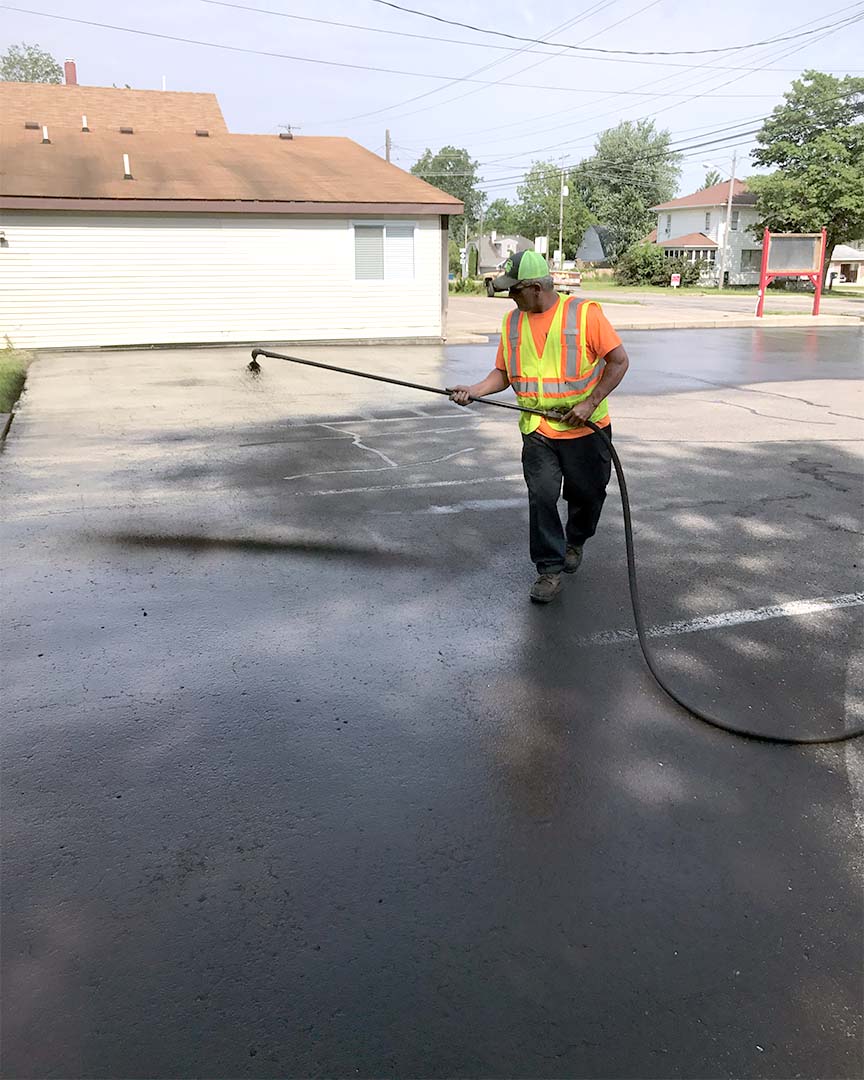Change Your Property's Aesthetic appeals: Commercial Parking Area Leading and Asphalt Sealing Solutions
Change Your Property's Aesthetic appeals: Commercial Parking Area Leading and Asphalt Sealing Solutions
Blog Article
Warm Mix Asphalt: A Lasting Service for Sidewalk
Hot Mix Asphalt (HMA) has arised as a leading sustainable choice for sidewalk options, using a myriad of environmental benefits and innovative innovations. As the need for environmentally friendly construction techniques expands, checking out the subtleties of HMA's sustainability can offer valuable understandings into the future of sidewalk services.
Ecological Benefits of Hot Mix Asphalt

In Addition, Hot Mix Asphalt aids to mitigate metropolitan heat island impacts. Its dark shade absorbs sunshine, decreasing the quantity of heat showed back right into the environment contrasted to lighter-colored pavements. This can reduce ambient temperature levels in urban locations, lowering the demand for a/c and inevitably minimizing power intake.
In addition, Warm Mix Asphalt adds to boosted stormwater management. Its porous nature enables water to reenergize and penetrate the sidewalk groundwater products, reducing runoff and the risk of flooding. These environmental advantages make Hot Mix Asphalt a lasting option for paving roadways and freeways.
Power Performance in HMA Manufacturing
Is energy efficiency a critical variable in the manufacturing of Hot Mix Asphalt (HMA)? Power plays a considerable role in the manufacturing of HMA, affecting both cost and ecological sustainability. One crucial aspect of power effectiveness in HMA production is the usage of warm mix asphalt (WMA) modern technologies.
Additionally, advancements in plant modern technologies have led to even more energy-efficient HMA production procedures. Modern plants are developed with attributes like recycled asphalt pavement (RAP) handling capabilities, reliable burner systems, and boosted insulation, all adding to power savings. By maximizing energy use in HMA production, the market can reduce its carbon footprint while preserving premium sidewalk materials. Power performance is, as a result, an important factor to consider in making sure the sustainability of Warm Mix Asphalt production.
Recyclability of Warm Mix Asphalt
The recyclability of Hot Mix Asphalt (HMA) is an essential aspect of its sustainability and long-lasting ecological impact. HMA is among the most recycled materials in the USA, with over 100 million loads of recovered asphalt sidewalk (RAP) being reused every year in new sidewalk construction. Reusing HMA supplies several environmental advantages, such as minimizing the demand for virgin products, lowering power intake during production, and lowering the amount of waste sent to land fills.
The procedure of recycling HMA involves crushing the existing pavement, crushing it right into smaller pieces, and blending it with new aggregate and asphalt binder to see it here create a recycled mix. On the whole, the recyclability of HMA plays a substantial function in promoting lasting techniques within the sidewalk market.

Long-Term Efficiency of HMA
Asphalt sidewalks show sturdiness and durability over an extensive duration, mirroring the lasting efficiency of Hot Mix Asphalt (HMA) The longevity of HMA can be credited to its ability to stand up to rush hour lots, rough weather, and the results of aging. Researches have actually shown that well-designed and correctly built HMA sidewalks can last for two decades or more with regular maintenance. The secret to maximizing the long-term performance of HMA depends on using top quality products, adhering to finest methods in building, and executing effective upkeep methods. Appropriate drainage, regular examinations, and prompt repair services are vital for sites protecting the structural honesty of HMA sidewalks in time. Additionally, advancements in HMA modern technology, such as making use of polymer-modified binders and cozy mix asphalt, have additionally enhanced the toughness and longevity of HMA sidewalks. By prioritizing top quality building and construction and upkeep methods, HMA proceeds to verify itself as a sustainable and cost-effective solution for durable pavement facilities.

HMA: Resilience and Sustainability
Showing both durability and sustainability, Warm Mix Asphalt (HMA) has become a cornerstone in the building and construction of lasting sidewalk facilities - hot mix asphalt. HMA's longevity comes from its capacity to endure hefty loads, extreme weather problems, and high traffic volumes, making it a reliable option for highways, freeways, and airport terminal runways. The structure of HMA, which typically includes accumulations, binder, and filler, plays an important duty in enhancing its durability and resistance to tear and wear
Additionally, HMA's sustainability depends on its recyclability and energy-efficient production process. The capacity to recycle reclaimed asphalt pavement (RAP) in brand-new HMA mixtures decreases the need for virgin products and reduces the ecological impact of sidewalk building and construction and maintenance. Furthermore, the energy performance of creating HMA depends on Read More Here its reduced blending temperature levels contrasted to various other sidewalk materials, resulting in lowered power usage and greenhouse gas exhausts.
Verdict
In final thought, hot mix asphalt (HMA) offers a lasting option for pavement with its environmentally pleasant attributes. HMA's recyclability, energy efficiency in manufacturing, and lasting longevity make it an eco-friendly option for road construction.
HMA is one of the most recycled products in the United States, with over 100 million lots of reclaimed asphalt pavement (RAP) being recycled yearly in brand-new pavement building.The procedure of recycling HMA entails milling the existing sidewalk, crushing it right into smaller pieces, and blending it with new accumulation and asphalt binder to create a recycled mix.Asphalt sidewalks demonstrate longevity and resilience over an extensive period, reflecting the long-term efficiency of Warm Mix Asphalt (HMA) Furthermore, advancements in HMA innovation, such as the use of polymer-modified binders and warm mix asphalt, have actually further boosted the longevity and longevity of HMA sidewalks. The ability to reuse reclaimed asphalt pavement (RAP) in brand-new HMA mixtures minimizes the need for virgin materials and reduces the ecological influence of pavement building and construction and maintenance.
Report this page